
This post includes NovaStar SmartLCT the most important information like the latest Novastar SmatLCT Download resources, user manual, key operation guides, etc.
More about NovaStar Resources can be obtained in the NovaStar Software Download Center or the LED Screen Cloud Platform.
NovaStar SmartLCT is a software that works with LED Controllers and computers to configure LED Screens. It’s smart and simple to use with visual operation. With the following key features, Download NovaStar SmartLCT could meet all your screen configuration needs.
- Recovering Receiving Card Parameters from the Factory.
- Online Software Update
- Replacing Receiving Card With One Click
- Building Screens like Building Blocks
- Rotating in 90° Increments
- Full 360° Rotation
- LED Display Test
- Update and Readback of Receiving Card Configuration Parameters
- Applying Effect to All Receiving Cards
- Receiving Card Program Upgrade
- Controller Program Upgrade
- Exporting Screen Configuration Information as images
Keep reading for more about NovaStar SmartLCT:
1. NovaStar SmartLCT Download & Installation
2. NovaStar SmartLCT User Guides
2.1 SmartLCT Screen Configuration
2.2 NovaStar SmartLCT Hot Backup
2.3 NovaStar SmartLCT Seam Brightness Adjustment
2.4 NovaStar SmartLCT Batch Adjustment
2.5 NovaStar SmartLCT V-Sender
2.6 Adjust Single Cabinet Colors
1. NovaStar SmartLCT Download & Installation
Access the LedInCloud Self-Service Cloud Platform for more NovaStar resources like NovaLCT or NovaStar RCFG File Download.
Click the links above to download the right SmartLCT for your LED Displays. After your download, install it just by running the application. Choose Chinese or English for your SmartLCT.
Note:
If you encounter any alerts from your antivirus or firewall during the setup process, please allow these actions to proceed. This is necessary for the installation of the required serial driver.
During the setup, the installer will automatically upgrade the serial driver on your computer to the version included in the setup package, should the existing driver be absent or outdated.
2. NovaStar SmartLCT User Guides
If your SmartLCT is used offline, some operations can be not finished like seam brightness adjustment, Accessing V-Sender, etc. Here we present some key Online operations for you. For all the guides, turn to the NovaStar SmartLCT Download & Installation part.
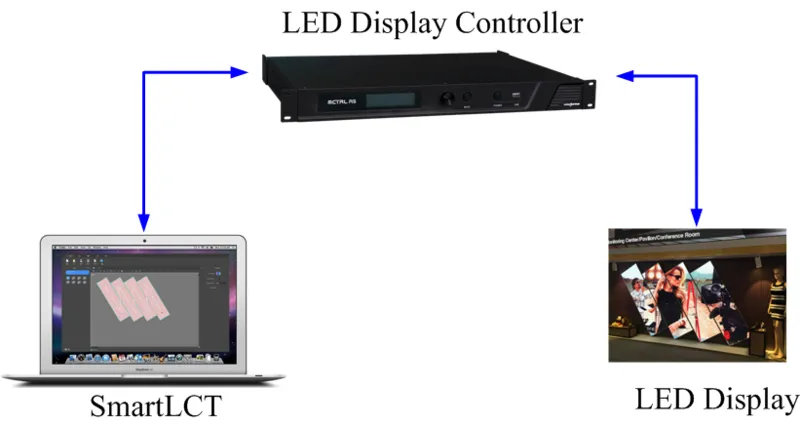
2.1 SmartLCT Screen Configuration
a. Adding Cabinets
Step 1: Select the device type and Ethernet port type.
Step 2: Under the Edit ab, you can add cabinets using any of the methods below:
Method 1: Click Batch Add, input the details for the new cabinets, and confirm by clicking OK. Position the cursor over the canvas and click to place the cabinets.
Method 2: Choose a specific cabinet icon, and navigate to the canvas. Click and hold the left mouse button to position the cabinet. To cease adding cabinets, right-click.
b. Cabinet Configuration
Connecting Cabinets: Ensure cabinets are connected before initiating screen configuration by following one of these methods:
Method 1: Automatic Connection
- On the “Create a new project” interface, once you’ve determined the cabinet arrangement, opt for “Auto Connect” and select the preferred connection style.
- Cabinets that surpass the single Ethernet port’s capacity limit cannot be linked.
Method 2: Manual Connection
- Place cabinets on the canvas and highlight the ones you wish to connect. In the “Cabinet Connection” menu of the toolbar, select a connection style. Connections will halt if the cumulative load of the cabinets exceeds the Ethernet port’s maximum capacity.
- Position cabinets on the canvas. Click to pinpoint the center of the desired cabinet and drag the cursor to the center of the subsequent cabinet, continuing this process.
Methods 3: Keyboard Shortcut Connection
- With the mouse, select the initial cabinet. Concurrently press Shift and the directional arrow keys (Up/Down/Left/Right) to choose and link cabinets.
- This method is compatible solely with standard cabinets.
Grouping Cabinets:
Step 1: In the canvas, select the target cabinets and click ![]() (or right-click to choose Group).
(or right-click to choose Group).
Step 2: With the cabinets grouped, access the “Properties” section to assign a group name, color, and the position of the grouped cabinet.
The grouped cabinets will be edited as a whole.
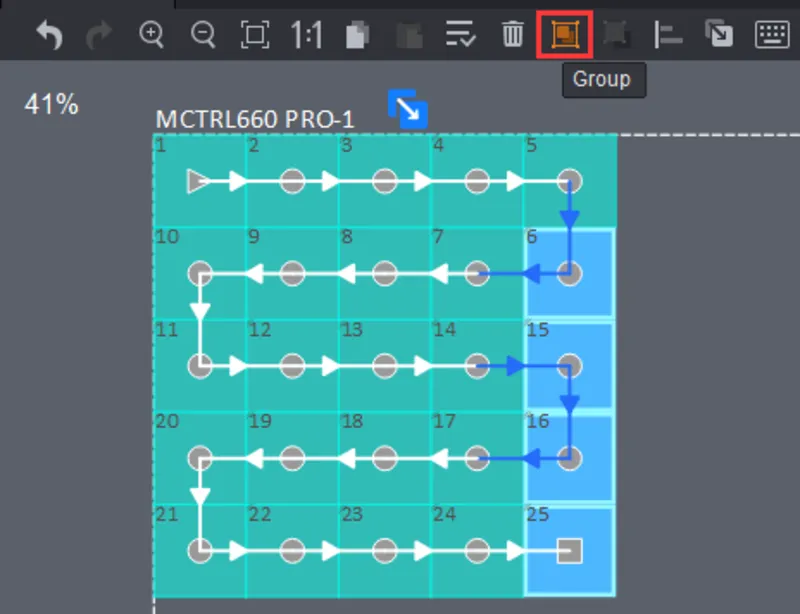
Disconnecting Cabinets: Select the target cabinets and click ![]() in the toolbar, or right-click to choose Delete Connection.
in the toolbar, or right-click to choose Delete Connection.
c. Setting Cabinet Offset
After adding and connecting cabinets, a dotted rectangle will frame the cabinets, indicating the connected device’s loading capacity.
Step 1: Click ![]() and drag a cabinet to change its position relative to the dotted rectangle.
and drag a cabinet to change its position relative to the dotted rectangle.
Step 2: Click ![]() to quit the edit.
to quit the edit.
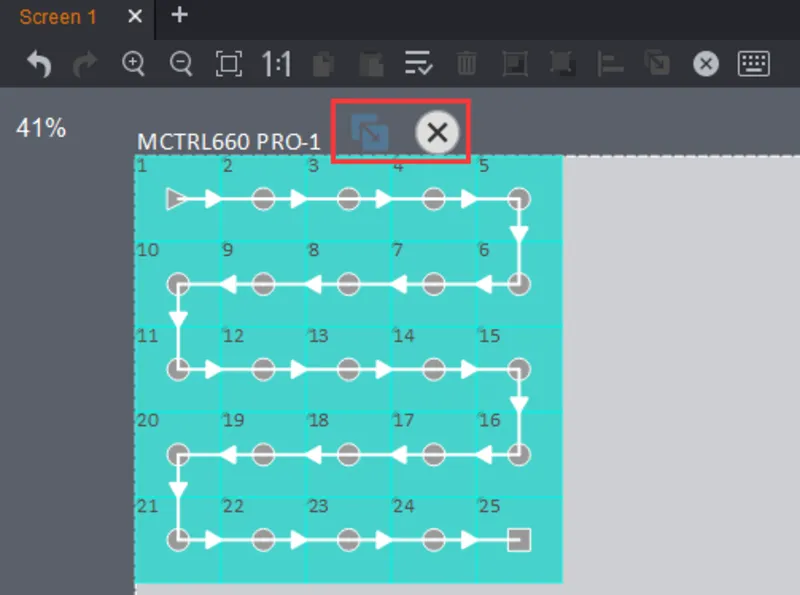
d. Rotating Cabinets
If the added device is equipped with a rotation feature, follow these steps to rotate the cabinets, using MCTRL R5 as an example:
Step 1: Click ![]() and rotate the rotation bar to rotate the cabinets to the desired orientation (or enter a specific rotation angle).
and rotate the rotation bar to rotate the cabinets to the desired orientation (or enter a specific rotation angle).
Step 2: Click to quit the edit.
2.2 NovaStar SmartLCT Hot Backup
a. Backup Within Device
Step 1: Select a device from the device area, drag it onto the canvas, and click to place the device.
Step 2: Click ![]() at the top right of the device. The Ethernet ports will automatically be backed up. This backup configuration cannot be modified.
at the top right of the device. The Ethernet ports will automatically be backed up. This backup configuration cannot be modified.
Step 3: (Optional) Click to choose the backup Ethernet port and drag it to the desired Ethernet port to set up a backup between Ethernet ports.
Note:
- To remove the backup of Ethernet ports, click
 at the top right of the device.
at the top right of the device. - To delete a backup between two Ethernet ports, click
 between two Ethernet ports to delete the backup. Click
between two Ethernet ports to delete the backup. Click  at the top right of the device to delete the device.
at the top right of the device to delete the device.
b. Backup Between Devices
Hot backup between devices is only available for the devices with the same communication ports.
Step 1: Choose a device from the device area, drag it to the canvas, and click to place the device.
Step 2: Drag another device to the target device. The backup between the two devices will be established automatically.
Step 3: (Optional) Click to select the backup Ethernet port and drag it to the target Ethernet port to perform Ethernet port backup between devices.
Note:
- Once the backup is configured, the
 icon will appear on the line connecting the two devices. Click this icon to switch between master and slave.
icon will appear on the line connecting the two devices. Click this icon to switch between master and slave. - To delete a device, click
 at the top right of the device.
at the top right of the device. - To remove the backup, Click
 at the top right of the dashed box.
at the top right of the dashed box. - The slave device is not eligible for screen configuration tasks.
2.3 NovaStar SmartLCT Seam Brightness Adjustment
Step 1: Navigate to the Device tab and click ![]() to access the seam brightness adjustment interface.
to access the seam brightness adjustment interface.
Step 2: Select the target seam, and the seam will turn blue.
Step 3: (Optional) Choose the desired precision level for the adjustment.
Step 4: Adjust the seam brightness by dragging the slider located next to the Selected Area Parameter Adjustment, and the borders will turn green.
Step 5: Type “admin” to access the factory area and user area settings page.
- Save to Factory Area: Store the seam brightness adjustment settings in the receiving card’s factory area. These settings are retained for maintenance purposes once the cabinet returns to the factory.
- Save to User Area: Store the seam brightness adjustment settings in the receiving card’s user area. These settings are applied for on-site screen adjustments.
- Load Factory Area: Restore seam brightness adjustment parameters to the parameters last saved in the factory area.
- Load User Area: Restore seam brightness adjustment parameters to the parameters last saved in the user area.
Step 6: Save seam brightness adjustment parameters to the sending device.
2.4 NovaStar SmartLCT Batch Adjustment
To ensure uniform image display on the LED screen, adjust the brightness and chroma of cabinets from different batches.
Initially, configure the LED display and store the configuration settings in the hardware.
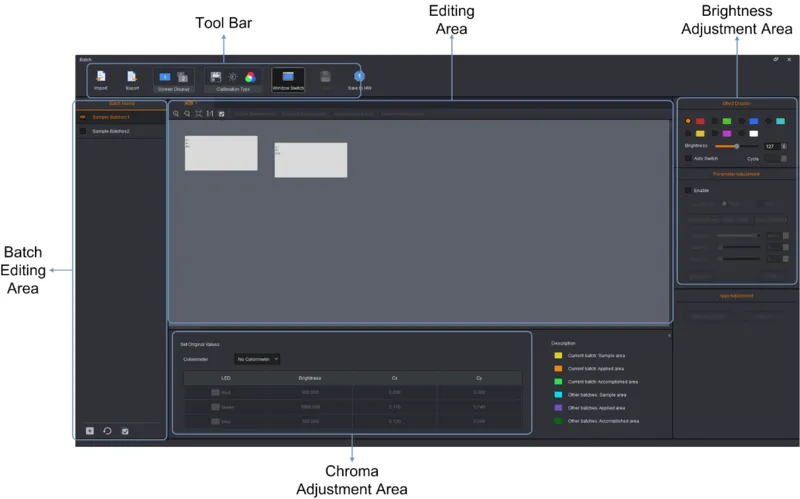
Step 1: Select a batch.
Step 2: In the editing area, select the cabinets or modules of the batch, and Add to Sample Area.
Step 3: Adjust chroma and brightness.
Step 4: Click Apply Adjustment.
Step 5: Click Save to HW.
Note: It’s essential for each batch to include the sample area details.
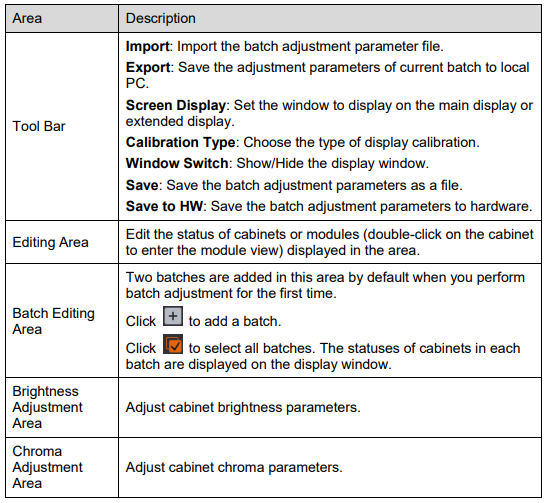
2.5 NovaStar SmartLCT V-Sender
On the NovaStar SmartLCT V-Sender page, we can see the working statuses of Ethernet ports, change the input source type, set the screen control mode, select the Canva template, picture-in-picture, etc.
a. How to Enter the SmartLCT V-Sender Page
Method 1: On the start page, click in the Device List section to open V-Sender, as depicted below.

Method 2: In the Device section of the editing page, click ![]() to open V-Sender, as shown in the figure below.
to open V-Sender, as shown in the figure below.
b. Adding Devices
Step 1: At the bottom of the device list, click ![]() to open the Add Devices page.
to open the Add Devices page.
Step 2: Select the devices you want to add and click OK.
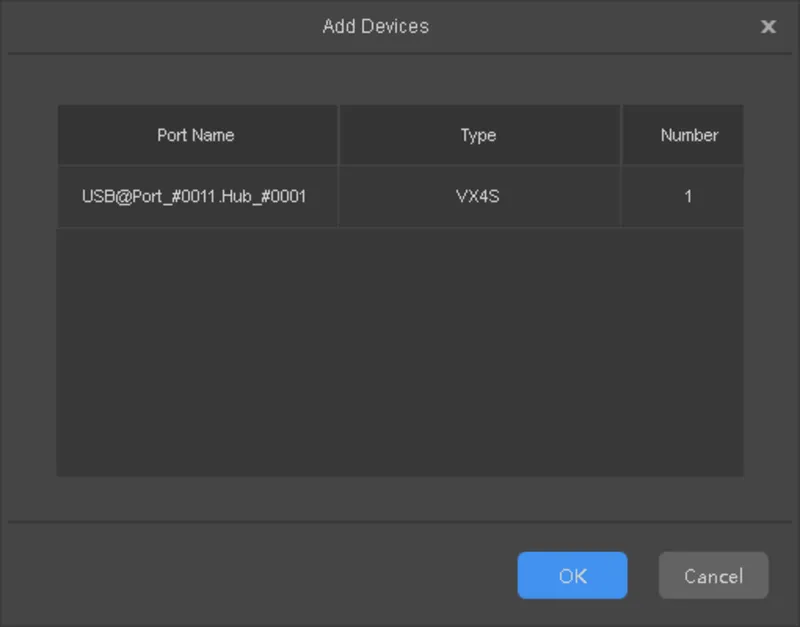
c. Ethernet Port Statu Information on NovaStar SmartLCT

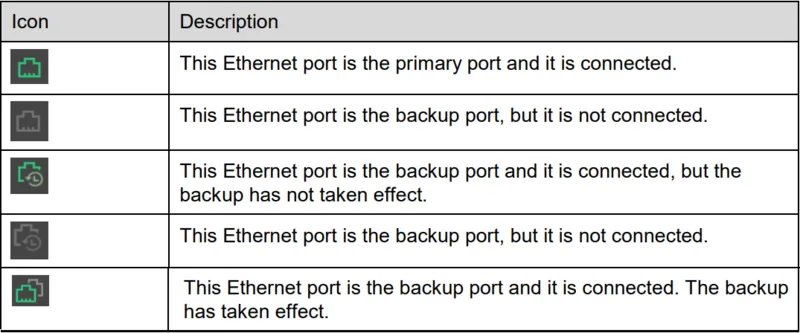
d. Control Tab
The Control tab on the SmartLCT V-Sender page enables switching of the input source type and setting of the screen mode. Screen control mode includes:

e. Mosaic
Note: Utilize the mosaic function when the pixel count of the output image surpasses a single device’s loading capacity
Step 1: Access V-Sender. On the Output tab, select Mosaic.
Step 2: Set parameters through any of the following methods.
- Non-Equal Division: When the loading capacities of each of the VX4S units are different, set the total number of pixels of the LED display, the loading area of the current device, and the start position.
- Equal Division: When the loading capacities of each of the VX4S units are the same, set the total number of pixels of the LED display, the number of mosaic rows and columns, and the start position of the loading area of the current device.
Step 3: Once parameter settings are finalized, click Apply to transmit the settings to the hardware.
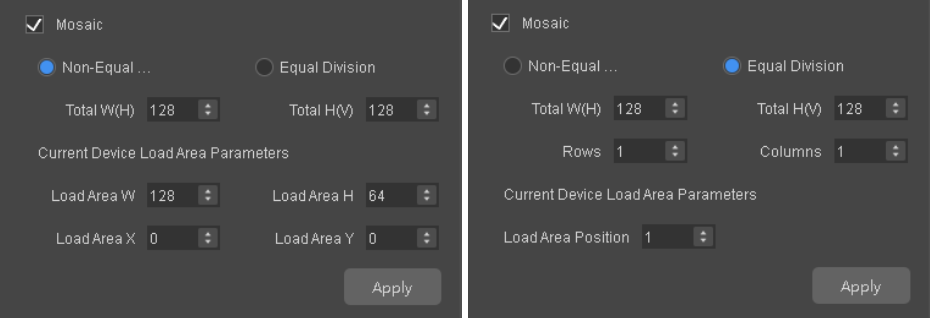
f. Operation Video
2.6 Adjust Single Cabinet Colors
Step 1: Click Create Online Design, and follow the steps go to main edit page.
Step 2: Choose the cabinet you want to adjust, go to right property pages, click Color and Customized Color Temperature. Then drag the color bars to adjust the colors for single cabinet.
2.7 SmartLCT Operation Guides Videos
3. SmartLCT VS. NovaLCT
SmartLCT: Simplifying Complexity
User-friendly Interface: SmartLCT is built for users with less technical experience, offering an intuitive graphical interface. It simplifies the configuration process, which makes it accessible to a wider audience.
Creative and Flexible Design: One of the standout features of SmartLCT is its ability to achieve 360° rotation and innovative screen layouts. This flexibility is perfect for creative presentations.
Batch Uniformity and Stability: SmartLCT solves uniformity issues that may arise from different production batches by modifying coefficients to harmonize the display. In addition, its dual hot backup function guarantees consistent data flow and display stability.
NovaLCT: The Professional's Choice
Geared for Industry Experts: NovaLCT is designed with professionals in mind—manufacturers, developers, and technical support engineers. Its comprehensive feature set is tailored to meet the needs of those who require precise control over their LED displays.
Feature-Rich and Reliable: NovaLCT is packed with tools that allow for detailed LED display management. Users can fine-tune brightness and chroma, perform calibration, and handle intricate screen setups.
Optimal for Novastar Systems: When using Novastar’s synchronous control systems and multimedia players, NovaLCT stands out as the recommended software. Its advanced features align perfectly with the high-performance standards of Novastar products.
Choosing the Right Tool
Both SmartLCT and NovaLCT are powerful tools in the field of LED display technology, each with its own unique advantages. NovaLCT caters to professionals seeking advanced features and precise control, while SmartLCT offers a user-friendly and flexible solution for creative and efficient display management.
4. Conclusion
In the field of LED display technology, choosing NovaStar SmartLCT can significantly impact the quality and efficiency of visual presentations. It is a versatile and user-friendly solution that enables users to easily achieve professional results. Download SmartLCT now to help your LED display achieve the most value!



